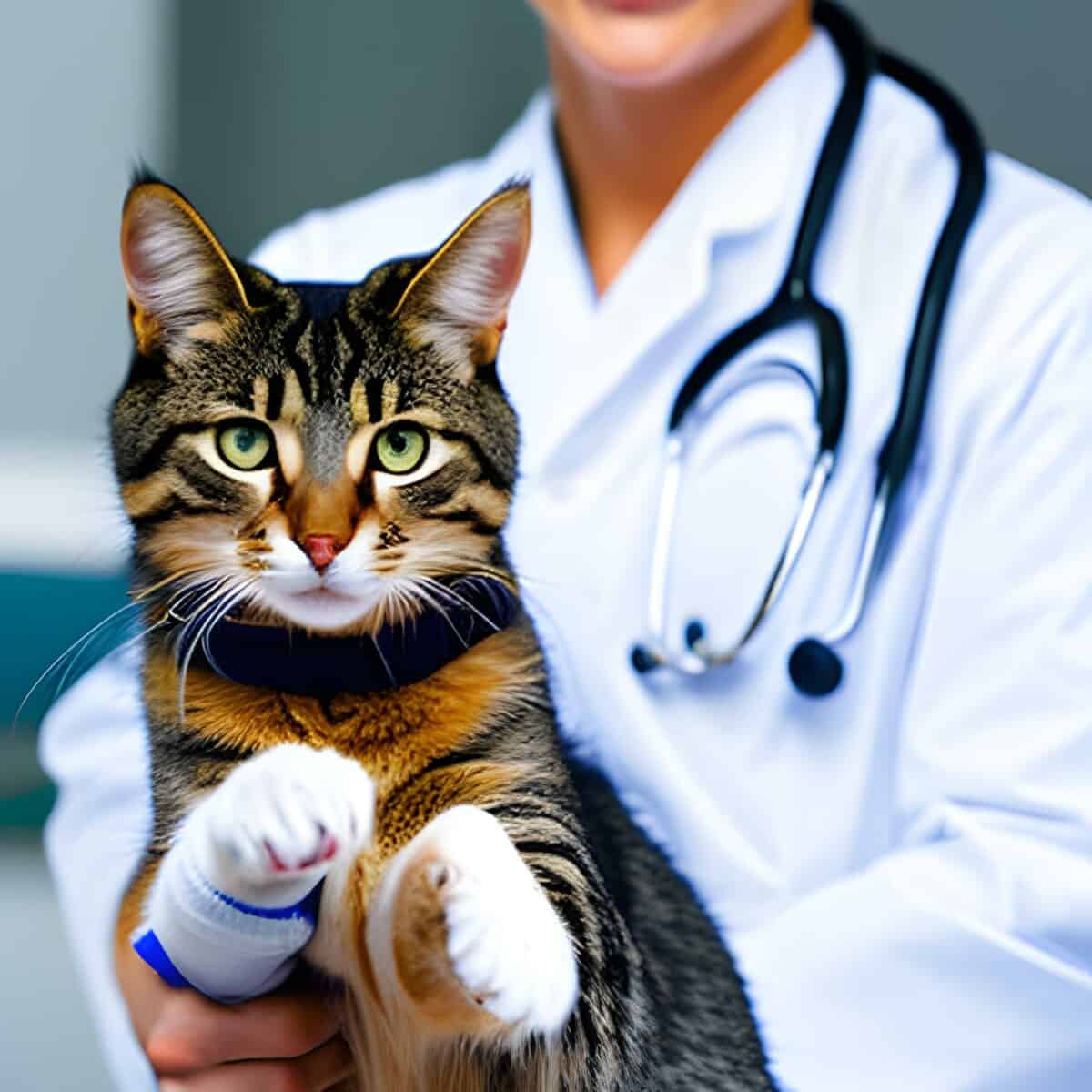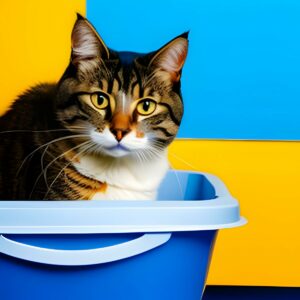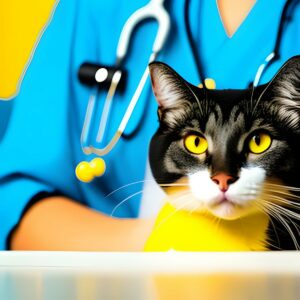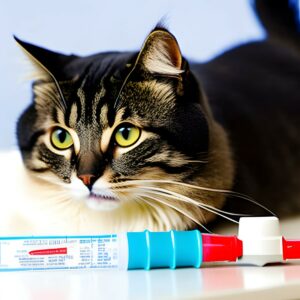Cats are known for their independent nature and their ability to hide their pain or sickness, making it challenging to recognize when they need professional help.
So, how to tell if your cat is sick?
Every cat has their own character, habits, and patterns. That’s why you need a keen eye and some detective work to notice early signs.
Unfortunately, obvious signs are shown when health issue progresses.
In this guide, we’ll discuss the indications that your cat needs a vet check-up, including behavioral and physical symptoms.
As always I will try to prepare you for a vet visit by including potential medical issues that follow symptoms.
Let’s start.
How to Tell If Your Cat Is Sick: Table of Contents
Normal vs Abnormal Cat Behavior
First signs that something is wrong will show in your cat’s behavior and then physical symptoms become more noticeable.
So, the first thing to do is to think about your cat’s normal behavior and note changes.
Here are some general signs to consider first:
Normal Cat Behavior:
- Grooming: Cats are known for their meticulous grooming habits. Regular grooming, including licking their fur, is considered normal behavior.
- Playfulness: Cats are typically active and playful animals. Engaging in interactive play and exhibiting bursts of energy is normal for them.
- Eating habits: Cats have individual eating patterns, but maintaining a regular appetite and showing enthusiasm for food is generally normal. Healthy cats typically have a good appetite and eat their meals without hesitation.
- Litter box habits: Using the litter box consistently and without difficulty is considered normal. Cats instinctively bury their waste, and any changes in litter box behavior may indicate an issue.
- Social behavior: Cats can exhibit both independent and social behaviors. It’s normal for them to seek human interaction, enjoy being petted, and display affection in their own unique ways.
- Sleeping patterns: Cats are known for their love of napping. They tend to sleep for long periods throughout the day, which is generally normal behavior.
Abnormal Cat Behavior (indicating illness):
- Changes in appetite: A sudden decrease or increase in appetite can be a sign of illness. Loss of appetite may indicate various underlying health issues, while an increase in appetite can be a symptom of conditions like hyperthyroidism or diabetes.
- Lethargy: If a normally active and playful cat becomes excessively lethargic, it may indicate an underlying health problem. Lack of energy, constant tiredness, or spending unusually long periods sleeping can be signs of illness.
- Changes in litter box behavior: Increased or decreased urination, straining, urinating outside the litter box, or blood in the urine may indicate urinary tract issues, kidney problems, or other health conditions.
- Changes in water consumption: An increase or decrease in water intake can be a sign of various medical conditions, including kidney disease or diabetes.
- Behavioral changes: Unexplained aggression, excessive vocalization, hiding, or other significant changes in behavior can indicate pain, discomfort, or underlying health problems in cats
- Unusual vocalization: Cats may meow for various reasons, but persistent, excessive, or unusual vocalization can indicate distress, discomfort, or illness
1. Changes in Coat Condition
A cat’s coat can tell a lot about its overall health. If you notice that your cat’s fur is dull, oily, or matted, it could be a sign of an underlying health condition. Skin conditions, allergies, and parasites can all affect a cat’s coat.
Over-grooming or Under-grooming
A cat that is over-grooming may develop bald patches or irritations on their skin, while a cat that is under-grooming may have matted fur or a dull, unkempt coat. Both of these situations could indicate an underlying skin condition or discomfort.
Over-Grooming is a sign of:
Allergies: Cats may over-groom themselves due to allergies, such as flea allergy dermatitis or food allergies. Excessive scratching and licking can lead to skin irritation and hair loss.
Skin Infections: Over-grooming can also be a response to skin infections caused by bacteria, fungi, or parasites. Cats may excessively groom the affected areas, trying to alleviate the discomfort.
Stress and Anxiety: Cats may over-groom as a response to stress, anxiety, or boredom. This behavior is known as psychogenic alopecia, and it can result in hair loss and skin damage.
Pain or Discomfort: Cats may excessively groom a specific area if they are experiencing pain, such as arthritis or an injury. It can serve as a way to self-soothe or relieve discomfort.
Under-Grooming is a sign of:
Health Issues: Cats that under groom may be experiencing health problems that affect their energy levels or mobility. Conditions such as arthritis, dental pain, or obesity can lead to decreased grooming behavior.
Obesity: Overweight cats may find it challenging to groom themselves effectively, leading to a decrease in grooming behavior. This can result in a dull coat, matting, or hygiene-related issues.
Depressed or Sick Cats: Cats that are feeling unwell or are emotionally distressed may exhibit reduced grooming. This change in behavior may be a result of a systemic illness, pain, or stress
Matted Fur or Hair Loss
Excessive matting of fur or hair loss is not normal and could indicate that your cat is dealing with a skin condition or experiencing pain or discomfort. These symptoms could also indicate an underlying medical condition such as a thyroid issue, so seeking veterinary care is crucial.
2. Changes in Urination
Changes in your cat’s urination habits could be a sign of a urinary tract infection or kidney disease.
If you notice that your cat is urinating more frequently than usual, it could indicate urinary tract infections (UTIs), diabetes, kidney disease, or bladder stones.
If your cat shows signs of discomfort while urinating, such as straining, crying, or spending an extended amount of time in the litter box, it may indicate a blockage in the urinary tract.
Blockages can be caused by crystals, stones, or a urethral obstruction, which is a life-threatening condition requiring immediate veterinary attention.
Pay attention to any changes in the color, odor, or consistency of your cat’s urine. Blood in the urine (hematuria) can be a sign of various conditions, including UTIs, bladder inflammation, or bladder stones. Cloudy or strong-smelling urine can also indicate a problem.
If your cat starts urinating outside the litter box or if your cat is peeing everywhere it may indicate an underlying urinary issue. Cats with urinary discomfort may associate the litter box and type of litter with pain and choose alternative locations to urinate.
Cats with urinary problems often exhibit excessive grooming of their genital area. This behavior may be a sign of discomfort, inflammation, or irritation in the urinary tract
If your cat is urinating more frequently than usual, has accidents outside the litter box, or is straining to urinate, it is important to seek veterinary attention.
3. Lethargy or Lack of Interest in Play
Cats may become lethargic or lose interest in play when they are unwell or experiencing pain. Health conditions, such as infections, urinary tract problems, gastrointestinal issues, or respiratory infections, can cause discomfort and affect their energy levels.
When cats have a fever or are fighting off an infection, they may become lethargic and less interested in their usual activities, including play. The body’s immune response to an infection can lead to fatigue and reduced energy levels.
Certain systemic diseases, such as kidney disease or diabetes, can cause cats to feel lethargic and lose interest in play. These conditions affect the overall functioning of the body, leading to decreased energy levels.
Cats with anemia, a condition characterized by a low red blood cell count, may exhibit lethargy and a reduced desire to engage in play. Anemia can result from blood loss, nutritional deficiencies, or underlying diseases.
Age-related Changes: Senior cats may naturally experience a decrease in energy and playfulness as they age. However, it’s important to differentiate between normal age-related changes and abnormal lethargy. Any significant or sudden decrease in activity levels should be evaluated by a veterinarian.
4. Hiding or Avoiding Human Interaction
Cats are known to be independent creatures, but if your cat is hiding or avoiding human interaction, it could be a sign of discomfort or pain.
They instinctively seek a quiet and safe place to retreat when they don’t feel well.
Cats often hide when they are sick or injured. They may isolate themselves to conserve energy or protect themselves from potential threats. It can be a defensive mechanism to mask vulnerability.
Some medical conditions, such as urinary tract infections, gastrointestinal issues, or respiratory problems, can cause discomfort or pain, leading to hiding or avoidance. It is important to rule out underlying medical issues through a veterinary examination.
5. Changes in Eye or Nose Discharge
If your cat has discharge from their eyes or nose, it could be a sign of an upper respiratory infection or other health issue. Discharge can be clear or colored and may be accompanied by sneezing or coughing.
Eye Discharge could be a sign of:
Conjunctivitis: Inflammation of the conjunctiva, the thin mucous membrane lining the inner surface of the eyelids and coating the outer surface of the eye. It can cause redness, swelling, and a watery or thick discharge from the eyes.
Eye Infections: Bacterial, viral, or fungal infections can lead to eye discharge. The discharge may be clear, yellow, or green in color.
Feline Calicivirus Infection: Calicivirus is a common cause of upper respiratory infections in cats and can also affect the eyes. It may cause eye discharge along with other respiratory symptoms.
Nose Discharge could be a sign of:
Upper Respiratory Infections: Viral infections, including feline herpesvirus and feline calicivirus, are common causes of upper respiratory infections in cats. These infections can result in nasal discharge, which can be clear, watery, or thick.
Allergies: Cats can develop allergies to environmental factors, such as pollen or dust mites, which may lead to nasal discharge.
Sinus Infections: Infections in the sinuses can cause nasal discharge, which may be accompanied by other symptoms like sneezing and congestion
6. Unusual Lumps or Swelling
If you notice any unusual lumps, bumps, or swelling on your cat’s body, particularly in the abdomen, it’s crucial to seek veterinary attention. Lumps could suggest tumors, abscesses, or other skin conditions.
Types of lumps: Lumps and bumps on cats can be categorized as benign (non-cancerous) or malignant (cancerous). They can vary in size, shape, and texture and may be located on the surface of the skin or under the skin.
Causes of lumps: There are numerous causes of lumps in cats, including trauma-related injuries, infections, inflammatory lesions, cysts, abscesses, and tumors. Some lumps may develop as a result of external factors such as bug bites or parasites
7. Difficulty Breathing or Coughing
Difficulty breathing, also known as dyspnea, refers to significant problems inhaling and exhaling in cats.
Cats may exhibit heavy, noisy, fast, or shallow breathing, panting or open mouth breathing, pale gums, collapse, or even sudden/unexplained death.
Respiratory infections are one of the leading causes of difficulty breathing and coughing in cats. These infections can affect the upper respiratory tract, including the nasal passages, sinuses, oral cavity, pharynx, and larynx, as well as the lower respiratory tract, such as the trachea, bronchi, and lungs.
Feline viral respiratory diseases, such as feline herpesvirus and feline calicivirus, are highly contagious and can cause symptoms like coughing, sneezing, nasal discharge, and difficulty breathing.
Other potential causes of difficulty breathing and coughing in cats include:
Allergies: Cats can develop allergic reactions to certain substances, such as pollen, dust mites, or certain foods, leading to respiratory symptoms like coughing.
Asthma: Feline asthma is a chronic respiratory condition characterized by inflammation and constriction of the airways, resulting in coughing, wheezing, and difficulty breathing.
Heart disease: Certain heart conditions, such as congestive heart failure, can lead to fluid accumulation in the lungs, causing breathing difficulties and coughing in cats.
Fungal infections: Fungi, such as Aspergillus species primarily affect the respiratory system and may lead to coughing and difficulty breathing.
8. Increased Vocalization or Aggression
If your cat seems more vocal or aggressive than usual, it’s possible that they are in distress or pain. Aggressive behavior could indicate that your cat is trying to communicate that they need help.
Conditions such as:
- urinary tract infections
- dental problems
- arthritis
- gastrointestinal issues
can cause cats to exhibit these behaviors.
Age-related Changes: Older cats may vocalize more as they age, especially if they have conditions like cognitive dysfunction syndrome or vestibular disease. Increased vocalization can be a manifestation of confusion or disorientation in elderly cats.
Cognitive Dysfunction: Cats with cognitive dysfunction syndrome, a condition similar to Alzheimer’s disease in humans, may exhibit increased vocalization as a result of confusion, anxiety, or disorientation. These cats may also display aggression due to their altered mental state.
9. Bad breath
Bad breath, also known as halitosis, in cats, is not normal and can indicate an underlying health issue and dental disease.
Here are some possible causes and conditions associated with bad breath in cats:
Periodontal Disease: The most common cause of bad breath in cats is periodontal disease, which is caused by plaque bacteria in the mouth. Bacteria build-up can lead to inflammation, gum disease, and tooth decay, resulting in foul-smelling breath.
Dental Issues: Cats can develop dental problems such as dental abscesses, oral infections, or foreign objects stuck in the mouth, which can contribute to bad breath.
Systemic Diseases: Conditions such as kidney disease, liver disease, diabetes, and respiratory infections can produce unpleasant breath odor in cats.
Gastrointestinal Disorders: Certain gastrointestinal issues like gastrointestinal obstruction or diabetic ketoacidosis can also cause bad breath in cats.
Brachycephalic Breeds: Breeds with short-nosed, flat-faced features, such as Himalayans and Persians, are more prone to periodontal and mouth diseases due to their teeth being set close together.
10. Fever
Fever is an elevated body temperature that indicates an immune response to an underlying health issue in cats.
Here’s what you need to know:
- A cat’s normal body temperature typically ranges from 100.4º to 102.5º Fahrenheit (38º to 39.2º Celsius). When a cat’s body temperature rises above 102.5º F, it is considered a fever.
- Fever in cats can be caused by infections, inflammation, pain, anxiety, and certain medications. It is often a symptom of an underlying illness rather than a specific diagnosis itself.
Cats with a fever may exhibit several signs indicating their illness. Common symptoms include:
- Lethargy or weakness
- Lack of appetite
- Shivering or trembling
- Dehydration
- Warm ears when touched
- Rapid heart rate and increased respiratory rate
If you think your cat has a fever, you can read our guide to measure fever at home or to look for additional signs of fever in cats. (Click here to read about fever in cats: How to tell if your cat has a fever
11. Limping, injuries, or Wounds
While limping, injuries, or wounds can also result from accidents or physical trauma, it is important to consider potential medical causes as well.
Arthritis: Limping or difficulty in walking may be indicative of arthritis in cats. Arthritis is a common condition that affects the joints, causing pain, stiffness, and mobility issues. It is more prevalent in older cats but can also occur in younger individuals, especially if they have joint abnormalities or previous injuries.
Infections: Wounds or injuries in cats can become infected, leading to swelling, pain, and limping. Cats may develop abscesses, which are localized pockets of infection filled with pus. Abscesses are often caused by bites or scratches from other animals, and they require veterinary attention for treatment, including drainage and antibiotics.
Foreign Body Ingestion: Sometimes, cats may ingest foreign objects such as splinters, grass awns, or bone fragments. These foreign bodies can cause damage or blockage in the gastrointestinal tract, leading to pain, discomfort, and possibly limping. Ingested foreign bodies require prompt veterinary care to remove the object and prevent complications.
Trauma: Cats can experience falls, accidents, or altercations with other animals. These incidents can result in injuries, including fractures, sprains, or soft tissue damage, which may cause limping or difficulty in moving. Immediate veterinary attention is necessary to assess and treat the injuries appropriately.
Tumors: In some cases, limping or the presence of wounds may be associated with underlying tumors or cancerous growths. Tumors can affect the bones, muscles, or soft tissues, leading to pain, swelling, and mobility issues. A thorough examination by a veterinarian, potentially including imaging or biopsies, is necessary to evaluate and diagnose such conditions.
Systemic Illnesses: Limping, injuries, or wounds can also be a manifestation of systemic illnesses that affect multiple body systems. For example, certain infectious diseases, autoimmune disorders, or metabolic conditions can cause musculoskeletal symptoms, including lameness or wounds that don’t heal properly. Accurate diagnosis and appropriate treatment require a comprehensive evaluation by a veterinarian
12. Vomiting
Cats may occasionally vomit due to hairballs or mild stomach upset, which is generally benign and doesn’t indicate a serious problem. However, frequent or persistent vomiting can be a sign of underlying illness.
Acute Vomiting: Acute vomiting refers to sudden episodes of vomiting that last for 1 to 2 days without other accompanying symptoms. Most cases of acute vomiting are self-limiting and resolve without treatment. However, if vomiting persists or is severe, it is important to seek veterinary attention.
Chronic Vomiting: Chronic vomiting refers to ongoing vomiting that lasts for more than a couple of days and occurs several times per day. Chronic vomiting is often accompanied by other symptoms such as appetite loss, abdominal pain, weight loss, and depression. It requires veterinary attention and management.
Causes of Vomiting: Vomiting in cats can have various causes, including systemic illnesses, gastrointestinal issues, obstructions, food allergies, parasites, inflammatory bowel disease, pancreatitis, kidney or liver disease, infections, ingestion of toxic substances, and more..
Determining the underlying cause is crucial for appropriate treatment.
13. Diarrhea
While diarrhea itself is not a disease, it is a common symptom of underlying health issues in cats. Here are some key points to consider:
Diarrhea in cats can be caused by dietary changes, dietary indiscretion, intestinal parasites, infections (bacterial, viral, or parasitic), inflammatory bowel disease, food allergies, ingestion of toxins or foreign objects, and more.
Symptoms and Observations: If your cat is experiencing diarrhea, you may notice a change in the consistency and frequency of their stools.
The feces may be watery, soft, or unformed. Other symptoms that may accompany diarrhea include vomiting, loss of appetite, lethargy, increased thirst, and weight loss.
14. Constricted or dilated pupils
In healthy cats, the pupils constrict (become smaller) in bright light to reduce the amount of light entering the eye.
The pupils dilate (become larger) in dim light to allow more light in.
Abnormal Dilation:
Abnormally dilated pupils in cats can be a symptom of nerve dysfunction, retinal disease, eye conditions, injury, toxicity, medications, and brain conditions.
Dilated pupils, also known as mydriasis, may be unresponsive to light or only partially responsive, and one or both pupils may be affected.
Anisocoria:
Anisocoria refers to a significant difference in the size of the pupils between the two eyes. If you notice that one of your cat’s pupils is wider than the other, it is important to consult with a veterinarian as soon as possible.
Anisocoria can be a sign of an underlying problem in one or both eyes, and the abnormal eye may have either a smaller or larger pupil, depending on the cause.
Some possible causes of anisocoria in cats include:
Iris or Pupil Abnormalities: Anisocoria can occur due to structural abnormalities within the iris or the pupil itself. These abnormalities can affect the muscles responsible for regulating pupil size, leading to unequal pupil dilation or constriction.
Eye Trauma or Injury: In some cases, anisocoria can develop as a result of trauma or injury to the eye. Damage to the muscles or nerves controlling the pupil size can cause uneven dilation or constriction.
Inflammatory Conditions: Uveitis is characterized by inflammation of the uvea, which includes the iris, ciliary body, and choroid.
Neurological Disorders: Anisocoria can also be associated with neurological conditions that affect the nerves controlling the pupils. Nerve damage or dysfunction can disrupt the normal pupil response and lead to unequal pupil size.
Infections or Tumors: In rare cases, infections or tumors affecting the eye or nearby structures can cause anisocoria in cats. These conditions can interfere with the normal functioning of the pupil and result in unequal dilation or constriction.
Minor health issues vs emergencies
It is sometimes hard to predict if minor issues will turn into emergencies. However, the difference between these two is the time you have to respond.
For minor issues, you can observe your cat and take action if symptoms progress, but for emergencies, you should take your cat to the vet without hesitation ASAP.
Here are some examples, but the 4th paragraph plays an exceptional role.
1. Severity of Symptoms
Minor Issues:
Minor health issues in cats may exhibit mild symptoms that don’t appear to be life-threatening.
These can include:
- sneezing
- mild diarrhea
- mild vomiting
- small cut or scrape
Emergencies:
Emergencies typically involve severe or rapidly worsening symptoms. Examples include
- difficulty breathing
- uncontrolled bleeding
- prolonged seizures
- Choking
- extreme lethargy
- Collapse
- sudden paralysis
- severe pain
- ingestion of toxic substances
2. Duration of Symptoms
Minor Issues: Minor issues may have symptoms that are temporary or resolve on their own within a short period. For instance, sneezing due to mild allergies or a small cut that stops bleeding and starts healing.
Emergencies: Emergencies often involve symptoms that persist or worsen rapidly. These may include continuous vomiting or diarrhea, difficulty urinating, prolonged seizures, or acute collapse.
3. Impact on Daily Functioning
Minor Issues: Minor issues usually don’t significantly impact a cat’s daily activities or behavior. They may continue to eat, drink, play, and interact normally despite the minor ailment.
Emergencies: Emergencies tend to disrupt a cat’s normal functioning. Cats may be unable to eat or drink, exhibit extreme lethargy or weakness, have difficulty walking, or show signs of extreme pain.
4. Gut Feeling and Owner Intuition
Minor Issues: For minor issues, cat owners may have a sense that the problem is not overly concerning. They may observe their cat’s behavior and determine that it doesn’t warrant immediate veterinary attention.
Emergencies: In emergencies, cat owners often have a strong gut feeling that something is seriously wrong. If you have a sense of urgency, it’s best to err on the side of caution and seek immediate veterinary care.
How do you check a cat’s health at home?
I like asking this question, and each pet owner has their own approach.
Of course, home health checks are not a replacement for a vet, however, in practice pet owners like to have some sort of sense before they come to the clinic.
For example, if your cat is limping you instinctively want to check if there are any injuries, so you would slowly examine the leg, check for torns, swelling, etc.
So, here are some practical tips for cat health checks at home:
- Observe your cat’s behavior: Pay attention to any changes in your cat’s behavior, such as increased lethargy, excessive vocalization, aggression, or changes in appetite and water intake. Unusual behavior may indicate an underlying health problem.
- Check the eyes and ears: Look at your cat’s eyes and ensure they are clear, without any redness, discharge, or cloudiness. The ears should be clean and free from discharge or a strong odor.
- Assess the coat and skin: Examine your cat’s coat for any signs of hair loss, dryness, flakiness, or excessive shedding. Check for the presence of fleas, ticks, or skin irritations.
- Inspect the mouth and teeth: Lift your cat’s lips gently and check for healthy pink gums. Look for any signs of inflammation, redness, swelling, or tartar buildup on the teeth. Foul breath can indicate dental problems or other underlying health issues.
- Palpate the body: Gently run your hands over your cat’s body, feeling for any lumps, bumps, or abnormalities. Pay attention to any signs of discomfort or pain, such as flinching or vocalization.
- Monitor weight and body condition: Keep track of your cat’s weight and body condition over time. Sudden weight loss or gain can be a sign of an underlying health problem. Use a body condition scoring system to assess if your cat is underweight, overweight, or at an ideal weight.
- Check the litter box: Changes in urine or feces, such as increased frequency, changes in color, consistency, or odor, can indicate urinary or gastrointestinal issues.
- Assess mobility and gait: Observe how your cat moves and jumps. Any limping, stiffness, difficulty in climbing, or changes in mobility should be noted and investigated further.
Hopefully, we helped you understand the signs of illness in cats. Continuous monitoring of your furry family member is a part of Cat Care.
Remember to follow your gut feeling and don’t hesitate to take your cat to a checkup even if symptoms don’t look severe. The only way to have a piece of mind is to make sure your cat is healthy and happy.
My Senior Paws is a participant in the Amazon Services LLC Associates Program, an affiliate advertising program designed to provide a means for sites to earn advertising fees by advertising and linking to Amazon.com. We also participate in other affiliate programs which compensate us for referring traffic.




